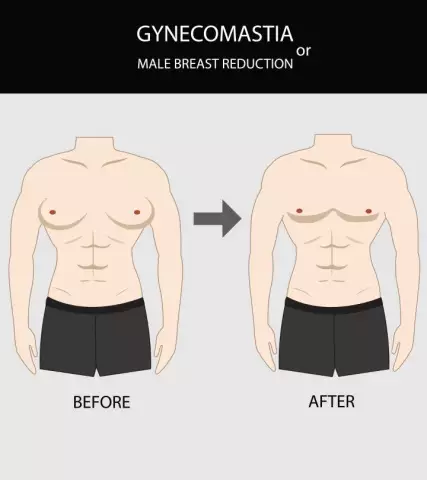- Author Rachel Wainwright [email protected].
- Public 2023-12-15 07:39.
- Last modified 2025-11-02 20:14.
Gynecomastia

Gynecomastia is a unilateral or bilateral benign enlargement of the mammary glands in men. Distinguish between false and true forms of pathology. In the first case, gynecomastia is caused by fatty deposits with excess weight, in the second - by the proliferation of breast tissue.
Causes and symptoms of gynecomastia
True gynecomastia in men is caused by:
- Violation of the ratio of estrogen and testosterone in the body. This condition is often observed with insufficient functioning of the gonads, hormonally active tumors of the testicles, pituitary gland, adrenal glands, lungs, pancreas and stomach, as well as with Addison's disease, inflammatory processes in the testes and prostate adenoma;
- Hyperprolactinemia - an increase in the secretion of the hormone prolactin in hypothyroidism and pituitary tumors;
- Diseases associated with metabolic disorders (obesity, diabetes mellitus, diffuse toxic goiter, etc.);
- Other non-endocrine diseases (liver cirrhosis, cardiovascular or renal failure, chest trauma, HIV infection, etc.);
- Taking a number of drugs that affect the receptors of the glandular tissue, increase the production of prolactin or estrogen, have a toxic effect on the testes, etc. Gynecomastia in men is caused by anabolic steroids, metronidazole, corticosteroids, enalapril, verapamil, cimetidine, creams containing estrogens, and many other drugs;
- The use of alcohol and drugs (marijuana, heroin).
The most characteristic symptom of gynecomastia is an increase in breast tissue and the appearance of seals in it. Sometimes, when touching, painful sensations appear, which periodically decrease and disappear completely.
Diagnosis of pathology
Before the removal of gynecomastia, or its treatment, an initial examination is necessary, which includes:
- Initial examination of the patient;
- Assessment of the degree of development of secondary sexual characteristics;
- Palpation of the testicles and mammary glands;
- Clarification of family and drug history;
- Analysis of existing diseases;
- Identification of alcohol or drug addiction.
If signs of gynecomastia are found, an endocrinologist's consultation is required, as well as a thorough hormonal examination. Laboratory diagnostic methods determine the content of hormones in the blood such as testosterone, estradiol, thyrotropin, prolactin, hCG (human chorionic gonadotropin), FSH (follicle-stimulating hormone) and LH (luteinizing hormone).
To identify a breast tumor and determine the nature of gynecomastia (false or true), ultrasound of the mammary glands is used.
Conservative treatment of gynecomastia
At the first stage of the disease (within four months after the beginning of the growth of the glandular tissue), it is possible to reduce the volume of the mammary glands by methods of conservative therapy. At the same time, getting rid of gynecomastia without surgery is quite simple. For this, hormonal therapy is prescribed, which normalizes the balance of testosterone and estrogen, and as a result, contributes to the reduction of the mammary glands.
With the conservative treatment of gynecomastia, the following drugs are used:
- Anti-estrogen drugs (eg tamoxifen). They are prescribed in case of excess estrogen in the male body. Antiestrogens block this subclass of steroid hormones and prevent them from affecting the mammary glands. The use of such drugs, despite their effectiveness, is limited by numerous side effects;
- Testosterone is a male sex hormone that is prescribed when its level in the body decreases. The positive effect of the drug is especially noticeable in hypogonadism, which is characterized by insufficient androgen secretion with underdevelopment or damage to the gonads. However, in physiological adolescent gynecomastia in men, testosterone administration is not always effective.
Surgical treatment of gynecomastia
In cases where conservative therapy does not give the desired result or it is initially clear that drug treatment will not help (for example, with tumor lesions), surgery is performed. When gynecomastia is surgically removed, the breast is excised and then restored to its physiological contour.
The indications for surgical treatment are:
- Large volume of glandular tissue;
- Pronounced cosmetic defect;
- The age of the pathology is more than a year.
Operations for gynecomastia are of the following types:
- Endoscopic mastectomy through an incision in the armpit (with a slight increase in the mammary glands);
- Subcutaneous mastectomy from periareolar incision with preservation of the areola;
- Subcutaneous mastectomy with liposuction.
The operation to remove gynecomastia is well tolerated by patients and does not require lengthy hospitalization and rehabilitation. In the first days after it, hematomas and slight swelling may be observed, as well as a feeling of discomfort in the chest. For 2-3 weeks after surgery, it is recommended to wear a special slimming underwear that helps to tighten the skin and shape the correct muscle contour. Physical activity should be excluded during the month. The recovery period for each patient is individual, and the final result is noticeable after about 12 weeks.

Contraindications for gynecomastia removal and surgery are as follows:
- Blood clotting disorder;
- Arterial hypertension;
- Endocrine diseases;
- Severe pathologies of the cardiovascular system;
- Oncological and infectious diseases;
- Chest trauma;
- Low contractility and elasticity of the skin.
With prolonged existence of gynecomastia, the risk of developing breast cancer increases. Therefore, if, in the presence of this pathology, bloody discharge from the nipples appears, seals form, the skin over the formation changes, the axillary lymph nodes increase, it is necessary to urgently consult a doctor.
YouTube video related to the article:
The information is generalized and provided for informational purposes only. At the first sign of illness, see your doctor. Self-medication is hazardous to health!






